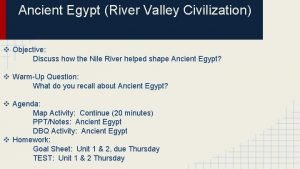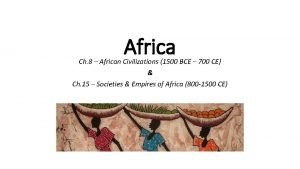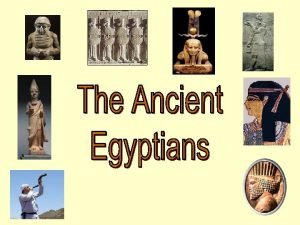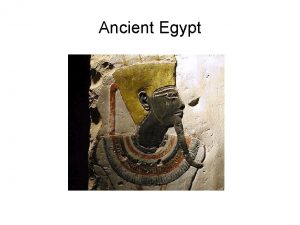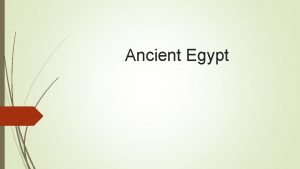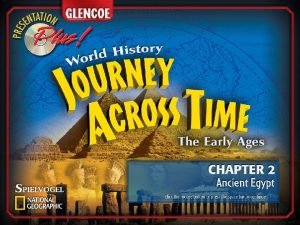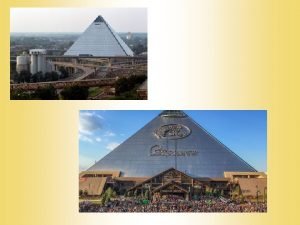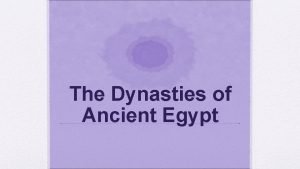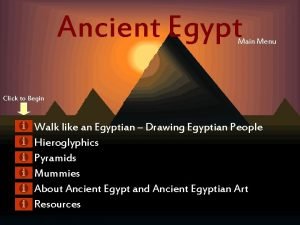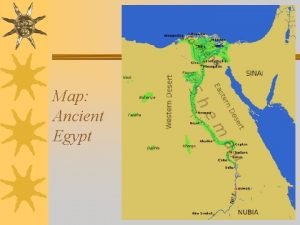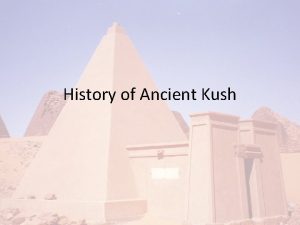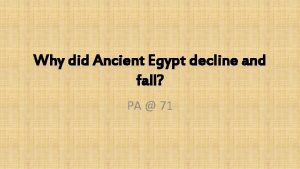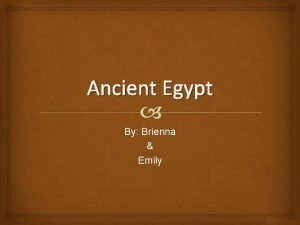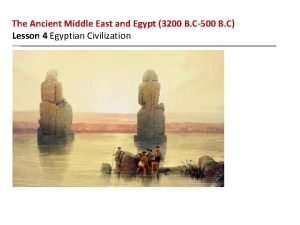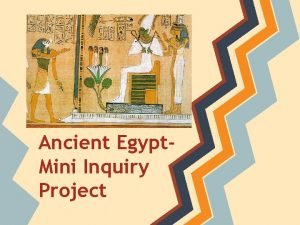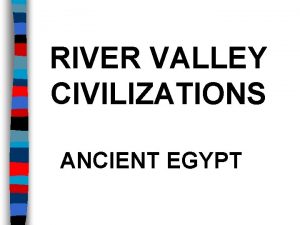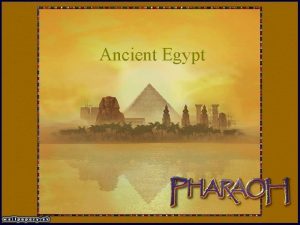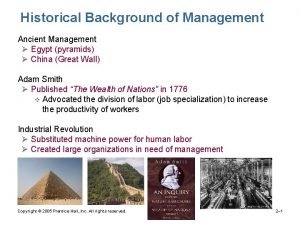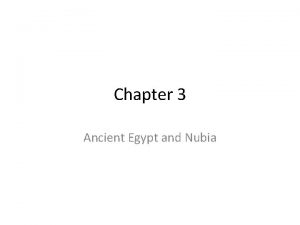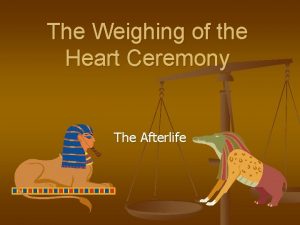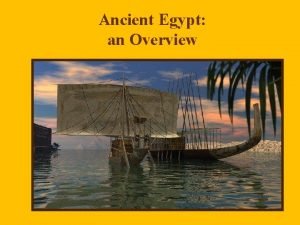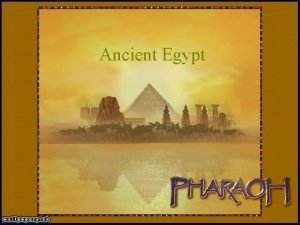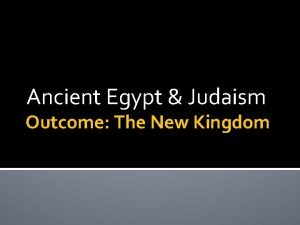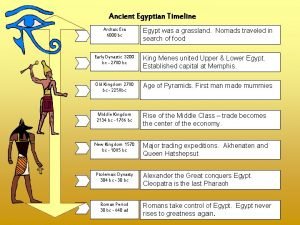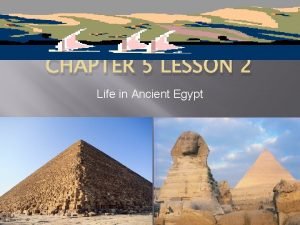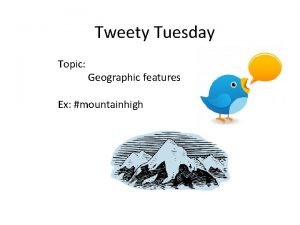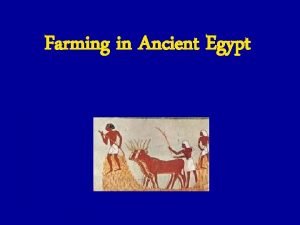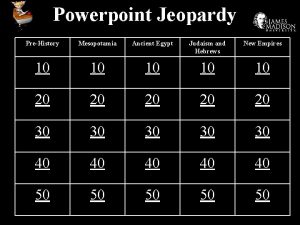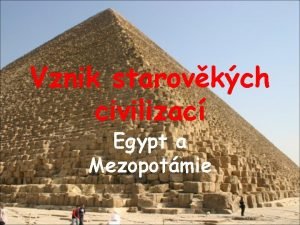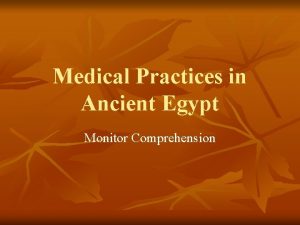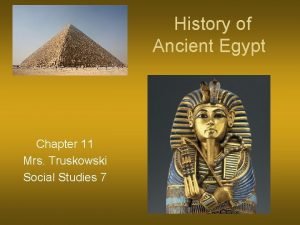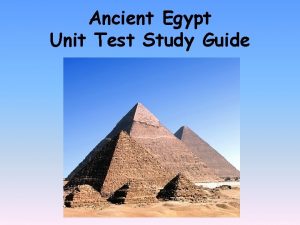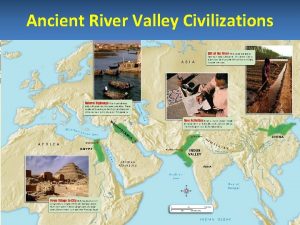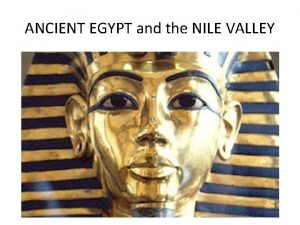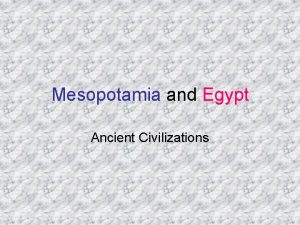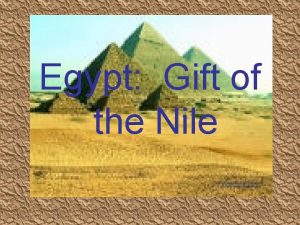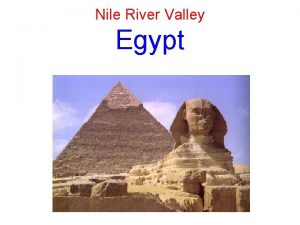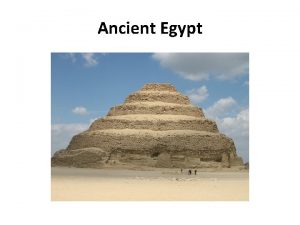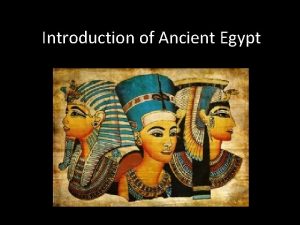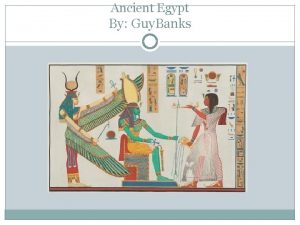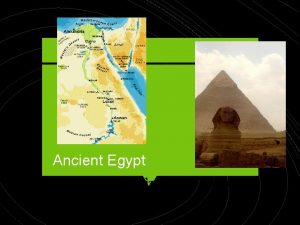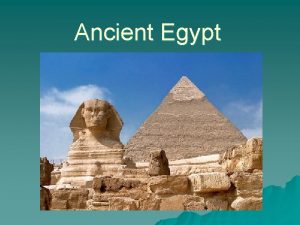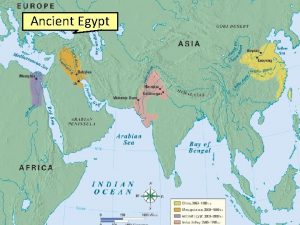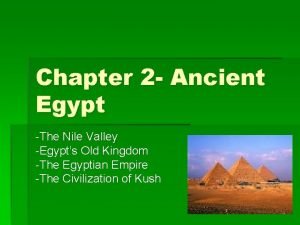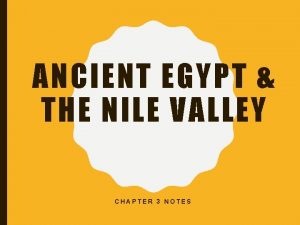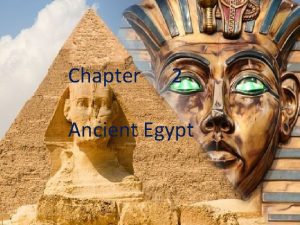Geography of the Ancient Nile Valley Egypt is



























































- Slides: 59


Geography of the Ancient Nile Valley • “Egypt is wholly the gift of the Nile. ” – Herodotus • People settled and established farming villages along the Nile. • Egyptians depended on annual floods to soak the land deposit a layer of silt, or rich soil. • Egyptians had to cooperate to control the Nile, building dikes, reservoirs, and irrigation ditches. • Rulers used the Nile to link and unite Upper and Lower Egypt. • The Nile served as a trade route connecting Egypt to Africa, the Middle East, and the Mediterranean world.

Egyptian Geography • More arid (dry) and more fertile than Mesopotamia • Divided into two parts – the Delta (Lower Egypt) – and the Upper Nile “south, ” not “north” is the important direction

Two Kingdoms: 3, 500 B. C. E. • two kingdoms • upper and lower Egypt • same culture • same language • same gods


Predynastic History of Egypt: Egypt Before the Pharaohs • Historians know little about Egyptian life in Predynastic times • Evidence suggests that a sophisticated culture existed before the Pharaonic Age • Amratian Period (4000 -3500 B. C. E. ) which is also known as Naqada I – Egyptians cultivated wheat & barley, domesticated goats, sheep, cattle, pigs, and domesticated the donkey & the cow – Egyptians made the first pottery, bricks, cosmetic palettes, and war maces

Egypt Before the Pharaohs: Pottery • Distinctive black-topped, red clay pottery used for food storage & transport • Pottery incised with scenes of hunting and everyday life

A mural of Narmer (or Menes) conquering Lower Egypt (c. a. 3100 B. C. E. )

Egypt Before the Pharaohs: Cosmetic Palettes • First mudstone palettes used to mix make-up appeared in the Amratian period • By late Gerzean period (c. 3100 B. C. E. ) lost original purpose and became more decorative votive pieces Hierakonpolis Palette

Egypt Before the Pharaohs: Earthenware

The “Zero” Dynasty (5500 -3100 B. C. E. ) • The “Zero Dynasty” emphasizes the many gaps in knowledge of Ancient Egyptian history • German archaeological work led to discovery of this dynasty – Discovery that kings reigned before the unification of Egypt – Early rulers known as “Horus-Kings” • The final phase of the Predynastic period • Power struggles for control all over Egypt took place between various factions – Struggles gave rise to the emergence of the first nation-state

• Narmer (Menes) & the Unification of Egypt Some people believe that "Menes" of been a real king, possibly Narmer. • King Menes was the founding king of the 1 st Dynasty, and was the first king to unify Upper and Lower Egypt into one kingdom. Ancient Egypt's most predominant form of civilization began with his crowning, and did not end permanently until the beginning of the Roman era, which started with Augustus Caesar.

Narmer (Menes) & the Unification of Egypt • Menes founded the city of Memphis, and chose as its location an island in the Nile, so that it would be easy to defend. He was also the founder of Crocodopolis. During his time, the Egyptian army performed raids against the Nubians in the south and expanded his sphere of influence as far as the First Cataract.

King Narmer (Menes) • Most of the things we know about prehistoric Egypt is all mixed up with legends. • One of the famous legends tells about King Menes who ruled Upper Egypt & how he defeated the king of Lower Egypt in 3100 B. C. E. • After this he united both lands and called himself king of both Upper Egypt and Lower Egypt. This double crown was there for the union of the two lands. King Menes and his family formed the first ever Egyptian dynasty. A dynasty is when you have a series of rulers who all come the same family. After King Menes died his son became king, when his son died his grandson became king.

Thinite Period • Early Dynastic period began with the unification of Egypt by Narmer (Egypt’s first pharaoh) • It lasted for 400 years and included the two earliest Ancient Egyptian dynasties • Major Innovations: – Monumental architecture (mud brick) which destroyed over time – Hieroglyphics developed • First just inscriptions with kings name, but evidence uncovers religious & medical literature developed Top Left: Ivory stature of a Thinite King (found in temple of Osiris at Abydos, wearing the white crown of Upper Egypt) Bottom Left: Dogs Hunting Gazelle (found in the tomb of Hemaka, the chancellor of Lower Egypt)

Historian have divided Egyptian history into three major periods: the Old Kingdom, the Middle Kingdom and the New Kingdom. • These were long periods of stability characterized by strong monarchical authority, competent bureaucracy, freedom from invasion, much construction of pyramids and temples, and considerable intellectual and cultural development and activity. • These major periods were punctuated by ages of political chaos known as the Intermediate Periods, which were characterized by weak political structures and rivalry for leadership, invasions, a decline in building activity, and a restructuring of society.

The Historical Periods of Ancient Egyptian History Early Dynastic Period c. a. 3100 -2700 B. C. E. The Old Kingdom c. a. 2700 -2200 B. C. E. First Intermediate Period c. a. 2200 -2050 B. C. E. The Middle Kingdom c. a. 2050 -1652 B. C. E. Second Intermediate Period c. a. 1652 -1567 B. C. E. The New Kingdom c. a. 1567 -1069 B. C. E. Third Intermediate Period c. a. 1069 -747 B. C. E. Late Period c. a. 747 -30 B. C. E.

Characteristics of the Three Kingdoms of Ancient Egypt OLD KINGDOM MIDDLE KINGDOM NEW KINGDOM • Pharaohs organized a strong central state, were absolute rulers, and were considered gods. • Large drainage project created arable farmland. • Traders had contacts with Middle East and Crete. • Egyptians built pyramids at Giza. • Corruption and rebellions were • Power struggles, crop common. failures, and cost of pyramids contributed to the • Hyksos invaded and collapse of the Old occupied the delta region. Kingdom. • Powerful pharaohs created a large empire that reached the Euphrates River. • Hatshepsut encouraged trade. • Ramses II expanded Egyptian rule to Syria. • Egyptian power declined.

PHARAOHS CROWNED WITH SHEPHERD’S CROOK AND FLAIL The Middle Kingdom (2050 -1653 B. C. E. ) was characterized by a new concern of the pharaohs for the people. In the Old Kingdom, Kingdom the pharaoh had been viewed as an inaccessible god-king. Now he was portrayed as the shepherd of his people.

The Crook & Flail • The crook (heka) and the flail or flabellum (nekhakha), are two of the most prominent items in the royal regalia of ancient Egypt. • Actual, very fine examples of both survive from ancient Egypt, as do statues and various wall reliefs, paintings and papyrus with representations of these objects.

The Crook & Flail • The crook and flail, though different scepters, could every so often be depicted separately, though usually paired with some other type of scepter, but they were most commonly represented together, held across the chest of the kings, Osiris, or other gods identified with them. • They were insignias of kingship, and while other deities could proffer them, they never kept them.

Khasekhemwy • Last ruler of the 2 nd Dynasty • United Egypt after a long period of turmoil and laid the foundations for development of the Old Kingdom • Old Kingdom began with his sons Sanakht & Djoser

The Old Kingdom: (c. a. 2700 -2200 B. C. E. ) • Golden Age of prosperity • Sneferu built 3 pyramids, but his son & successor, • Witnessed the Khufu credited with construction of the first building the Great Pyramid funerary monuments of Giza • Djoser most well-known pharaoh of 5 pharaohs of • Khufu’s son Khafra built another great pyramid & the 3 rd Dynasty Great Sphinx • 4 th Dynasty—Started with • Menkaura—built the last Sneferu and saw the pyramid at Giza and the last power of the pharaohs pharaoh of the 4 th Dynasty reach its climax

Tomb Complex of Djoser: • Second Pharaoh of the Old Kingdom • Built the first step pyramid at Saqqara, the largest necropolis in Memphis • Designed by architect Imhotep as a stone replica of Djoser’s palace • Built entirely from cut cubic stone

Pyramid of Nyuserra: • Pyramid built north of Saqqara in Abusir • Outside: regular stone used as outer casing • Inside: filled up with poor-quality stones and scree • Cut stones plundered & pyramid began to fall apart

Pyramids of Giza: • Built on the plateau of Giza at the edge of modern Cairo • House pharaohs of the 4 th Dynasty: – Khufu, Khafra, & Menkaura • Architecturally – Most impressive of pyramids in Egypt – Completely made of cut stone & largely remain intact today

Pyramid of Teti • Tomb monument built for the founder of the 6 th Dynasty • Located north of Saqqara • Architecturally, similar to the building techniques of the 5 th Dynasty – Contains similar dimensions – Contains satellite pyramids for two queens

• The new pharaoh established their capital at the strategic site of Memphis, just south of the delta, and over the next several centuries consolidated their rule. • Probably no other dynasty in history has been so successful in creating an effective yet apparently timeless form of government. • For thousands of years Egyptian pharaohs were able to convey to their subjects a sense of permanence and eternity while constantly adjusting the system to meet new needs. (Nagle, 23)

For administrative purposes, Egypt was divided up into provinces, or nomes. A governor, or nomarch, was at the head of each nome and was responsible to the pharaoh. These governors tended to amass large holding of land power within their nomes, creating a potential rivalry with the pharaohs. Of special importance to the administration of the state was a vast bureaucracy of scribes who kept records of everything. Armed with the knowledge of writing and reading, they were highly regarded and considered themselves a superior class of men. Their high standard of living reflected exalted status. Seated Scribe, from Saqqara. c. a. 2400 B. C. E. their

The End of the Old Kingdom Relief showing men, women, and children suffering from the effects of severe famine Professor Fekri Hassan examining ancient hieroglyphs which tell of appalling suffering. A third of the population died and the most ordered of empires was brought to chaos.

Decline of the Old Kingdom: (c. a. 2700 -2200 B. C. E. ) • Old Kingdom: the most stable period • the Pharaoh dominated life – forstalled the emergence of provincial power – but gradually lost power to royal officials • gradual drying of the environment – failure of the Nile to flood on time

First Intermediate Period: (c. a. 2200 -2050 B. C. E. ) th • The traditional structure • At the close of the 6 Dynasty, Egypt suffered of the Ancient Egyptian political and social decline. state dissolved at the end of the Old Kingdom • Insurrections weakened & divided the central • Egypt entered a period of government in Memphis political and economic uncertainty with no • Country torn apart for central figure to lead the more than a century by country political anarchy, social unrest, & invasions • Over the 40 years of the period, over 25 kings reigned over Egypt

First Intermediate Period: (c. a. 2200 -2050 B. C. E. ) • Decline of Old • Nomarchs: Kingdom began with – Poistion had been Pepy II hereditary since the 5 th – Old age & long reign caused him to lose control of the country – Many temples were freed from taxation and the chief administrators of the provinces (nomarchs) no longer had to pay tribute – Egypt became bankrupt Dynasty – Reigned supreme over their constituencies • Power of Pharaohs: – Resided in Memphis, reigned over Egypt in name only (no real power) – Actual influence limited to smal area & the Delta area was independent

Egypt and Nubia For centuries, Egypt traded or fought with Nubia. During the New Kingdom, Egypt conquered Nubia. • Nubians served in Egyptian armies and influenced Egyptian culture. • Egyptian art from this period shows Nubian soldiers, musicians, or prisoners. When Egypt declined, Nubia conquered Egypt. • Nubians did not see themselves as conquerors. • They respected Egyptian traditions.

Ancient Nubia • Fertile land in Nubia less than in Egypt • Nubia rich in mineral resources & luxury items: – Nubia was rich in gold, copper, & semi-precious stones – Nubia controlled trade routes to tropical Africa and its coveted supply of ivory, ebony, & animal skins • Egyptians set up settlements in Nubia to mine gold, quarry stone, smelt copper

The Middle Kingdom: • • (c. a. 2050 -1652 B. C. E. ) Pharaonic power reached its peak Referred to country’s “Golden Age” due to great heights in pictorial art & literature Egypt was reunited under the Eleventh Dynasty Deir el-Bahri from Thebes, not Memphis – followers of the god Amon – elevated to the rank of primary god Mortuary temple of Hatshepsut from above.

The Middle Kingdom: (c. a. 2050 -1652 B. C. E. ) • Period marked by a period of solidification of Egyptian borders • Military garrisons built on the borders • Marked by a period by which there was the suppression of the nobility; rise of the “middle class” Fortress of Buhen

The Middle Kingdom: The Vizier • • The chief advisor and administrator of the Pharaoh, was the tjaty, the vizier or prime minister. • The position of tjaty or vizier was in existence by the beginning of the Third Dynasty, the start of the Old Kingdom. • The vizier had authority and power that were second only to the Pharaoh, and sometimes perhaps rivaled the Pharaoh's authority. The vizier was responsible for civil order, the assessment and collection of taxes, the maintenance of archives, the mobilization of troops, appointment and supervision of officials, examination of land claims, inspection and surveillance of provincial governments, and the exercise of the law over civil cases.

The Middle Kingdom: The Vizier • Viziers were responsible for • They were also the registration of people and Overseer of Works for the property for tax purposes. royal monuments, and the holder had access to and • They supervised and control over vast recorded various manpower and material transactions, especially those resources by their control involving land, and as "sealof the corvee, a tax paid in bearers of the king, " they had the form of labor to obtain the authority to certify them. troops and workers for the • The viziers also supervised Pharaoh's building the biennial census of raw projects. materials, cattle, and produce.

The Middle Kingdom: The Vizier • The majority of Egyptian people were peasants who worked the land along the fertile Nile flood basin. • The corvee provided them with work during the annual flooding of the Nile, when their fields would be under water. • • These people had no voice in their government, and accepted this fact because it was backed by their religious beliefs that the pharaoh was a god and that they were worshiping him by doing his biding. • The land itself was divided up into provinces called nomes. Each nome had a governor, who was appointed by the Pharaoh, and responsible to the vizier.

The Middle Kingdom: The Vizier • There were courts in each nome and a high court in the capital, where the Viziers judged most of the cases. • By the 1400 s B. C. E. , the king appointed two viziers. • One vizier administered the Nile Delta area, and the other one managed the region to the south.

Reform in the Middle Kingdom: (c. a. 2050 -1652 B. C. E. ) • Successfully reduced the power of the nomarchs & the power over the nomes • Because the power & wealth of nomarchs rivaled that of the pharaoh, Senusret III abolished the nomes – He established a new form of regional government, thus consolidating power in the hands of the pharaoh Senusret III

Decline of the Middle Kingdom: (c. a. 2050 -1652 B. C. E. ) • After Queen Sobekeneferu’s death, the Middle Kingdom entered into a long period of decline • beginning of the Second Intermediate Queen Sobekeneferu

Second Intermediate Period (c. a. 1652 -1567 B. C. E. ) • King Kamose last king of the 17 th Dynasty • Decline of the Middle Kingdom gave rise to groups of Asiatics to establish settlements in the Delta region • Began a time of foreign rule in Egypt • Marked by a period of invasions by the Hyksos – Semitic peoples from Palestine – Hyksos dynasty by 1650 B. C. (Fifteenth Dynasty) King Kamose

Second Intermediate Period (c. a. 1652 -1567 B. C. E. ) • Period marked by localism, anarchy, short reigns, palace coups, assassinations – “seventy kings in seventy days” – a reversal of established order – dissolution of law and order – disruption of trade and agricultural production

The Hyksos • Ended the Middle Kingdom in Ancient Egypt by invasion • Semite Peoples • generate an imperialist response by Egyptians

The Hyksos • This site eventually became the capital of the Hyksos kings, yet within 50 years they had also managed to take control of the important Egyptian city of Memphis.

The Hyksos • The Hyksos were the source of the new horse-drawn war -chariots introduced to Egypt in the second half of the Hyksos rule. • This invention, never seen before in Egypt, was instrumental in the continued power of the Hyksos in this region. The Hyksos utilized superior bronze weapons, chariots, and composite bows to help them take control of Egypt, and by about 1720 B. C. E. they had grown strong enough, at the expense of the Middle Kingdom kings, to gain control of Avaris in the north eastern Delta.

Starting in 1567 B. C. E. , the pharaoh Ahmose I eventually managed to defeat and expel the Hyksos from Egypt, reuniting Egypt and establishing the New Kingdom (c. 1567 -1085 B. C. E. ). The New Kingdom was characterized by a new militaristic and imperialistic path. A more professional army was developed. Ahmose and his army driving out the Hyksos.

The New Kingdom (c. a. 1567 -1085 B. C. E. ) • New Kingdom began when the Theban rulers expelled the Hyksos kings – Considered the last glorious period of Ancient Egyptian History • Egypt expanded its borders to Syria in the north and to the Fourth Cataract of the Nile in Upper Nubia (modern Sudan) to the south – Conquests brought significant wealth to Egypt in the form of tribute (tax) as well as the influx of new ideas and influences – Both pharaohs and nobility enjoyed unprecedented luxury & refinement

Egypt during The New Kingdom (ca. 1450 B. C. E. )

The New Kingdom (c. a. 1567 -1085 B. C. E. ) • Reconquista of Egypt help to establish New Kingdom as a reaction to control by the Hyksos – “We had to destroy this village to save it. ” • Period marked a beginning of the imperial period – Egypt built a large, professional army – Egypt adopted a policy of planned aggression • This would create a “buffer zone” in Palestine • Egypt became more cosmopolitan • Resurgence of international trade • Reestablished the usual bureaucracy

Amenhotep IV (c. 13621347 B. C. E. ) introduced the worship of Aton, god of the sun disk, as the chief god and pursued his worship with enthusiasm. Changing his own name to Akhenaten (“It is well with Aton”), the pharaoh closed the temples of other gods and especially endeavored to lessen the power of Amon-Re and his priesthood at Thebes.

Battle of Qadesh (1274 B. C. E) • Egyptians & Hittites fought major battle in city of Qadesh – Both sides claimed victory • City located in modern-day Syria – Battle fought for control of its strategic • position on the trade route from the Euphrates River to • the Mediterranean Sea No decisive battle or clear winner declared, but truce declared and both sides returned home Egyptians maintained control of Palestine, but lost much land to the Hittites that they had captured during the war

Invasion of the “Sea Peoples” around 1200 B. C. E. The days of Egyptian empire were ended, and the New Kingdom expired with the end of the twentieth dynasty in 1085 B. C. E. For the next thousand years, despite periodic revivals of strength, Egypt was dominated by Libyans, Nubians, Persians, and Macedonians. Egyptian Drawings of Two Different Tribes of Sea People

Third Intermediate Period (c. a. 1069 -747 B. C. E. ) • After death of Rameses XI, the New Kingdom ended – Kings of the 21 st dynasty ruled the north from Tanis – High priests of Amun in Thebes held power in southern Egypt • Egypt again ruled by foreigners when the Libyans seized control of Egypt from 11841153 B. C. E. under the rule of Sheshonq I

Late Period (c. a. 747 -30 B. C. E. ) • 664 B. C. E. —Egyptians successfully regained their independence after being invaded by the Libyans, Nubians from the kingdom of the Kush, and the Assyrians • Saite Pharaohs restored the kingdom and encouraged a renaissance of Egyptian art • Egyptians now fostered a close relationship with: – The Greeks—some merchants became mercenaries in their armies – The Phoenicians—put their seafaring skills at their service • The last Saite pharaoh, Psamtek III, reigned for only 6 months before the Persians conquered Egypt in 525 B. C. E. )

Late Period (c. a. 747 -30 B. C. E. ) Alexander the Great as Pharaoh • In late 332 B. C. E. , Alexander the Great drove the Persians out of the Nile Valley • Egyptians saw Alexander as a “liberator” & recognized him as a pharaoh • Alexander founded the city of Alexandria, which became a prosperous commercial center and seat of culture

Late Period (c. a. 747 -30 B. C. E. ) Cleopatra: Egypt’s Last Queen • The most famous Egyptian of all time • She conceived a child (Ptolemy Caesarian) with Julius Caesar • After Caesar’s death, she returned to rule Egypt where she forged a relationship with Marc Antony • Her suicide in 30 B. C. E. brought to an end the last chapter in the 3, 000 -year story of Ancient Egypt
 How did the nile shape ancient egypt
How did the nile shape ancient egypt How did the nile shape ancient egypt dbq answer key
How did the nile shape ancient egypt dbq answer key What lasting legacies did the aksum kingdom leave
What lasting legacies did the aksum kingdom leave Ancient egypt civilization geography
Ancient egypt civilization geography Nubia
Nubia Egypt is the gift of the nile
Egypt is the gift of the nile Janapriya nile valley
Janapriya nile valley Ancient egypt advanced cities
Ancient egypt advanced cities Guided reading activity 2-1 the nile valley answer key
Guided reading activity 2-1 the nile valley answer key Upper egypt and lower egypt
Upper egypt and lower egypt Ancient egypt civilization
Ancient egypt civilization Relative location of ancient egypt
Relative location of ancient egypt Ancient egypt vocabulary words
Ancient egypt vocabulary words Workbook page 19
Workbook page 19 Frontalism ancient egypt
Frontalism ancient egypt Outline map of ancient egypt
Outline map of ancient egypt Ancient egypt and kush map
Ancient egypt and kush map Map of the kingdom of kush
Map of the kingdom of kush Ancient command economy
Ancient command economy Northern greece
Northern greece Ancient egypt basic needs
Ancient egypt basic needs Non chronological report about egypt
Non chronological report about egypt Ancient egyptian transportation
Ancient egyptian transportation Fomro
Fomro Ancient egypt british council
Ancient egypt british council Social hierarchy ancient egypt
Social hierarchy ancient egypt Economy of ancient egypt
Economy of ancient egypt Frontalism art
Frontalism art Natural barriers of china
Natural barriers of china Egypt map
Egypt map Ancient management
Ancient management Ancient egypt slogans
Ancient egypt slogans Map of ancient egypt and nubia
Map of ancient egypt and nubia What was the weighing of the heart ceremony
What was the weighing of the heart ceremony Three kingdoms of egypt
Three kingdoms of egypt Geographical map of ancient egypt
Geographical map of ancient egypt Specialized jobs in ancient egypt
Specialized jobs in ancient egypt Ancient egypt and judaism outcome the new kingdom
Ancient egypt and judaism outcome the new kingdom Ancient greece jeopardy
Ancient greece jeopardy Nubian religion
Nubian religion Ebers papyrus
Ebers papyrus Egyptian social pyramid
Egyptian social pyramid Social classes
Social classes What crops did ancient egypt grow
What crops did ancient egypt grow Ancient egypt jeopardy
Ancient egypt jeopardy Ancient egypt bell ringers
Ancient egypt bell ringers Geometric mass floral design
Geometric mass floral design Kleopatra hrobka
Kleopatra hrobka Egypt social pyramid
Egypt social pyramid Ancient egypt
Ancient egypt Easy egyptian drawings
Easy egyptian drawings Medical practices in ancient egypt answer key
Medical practices in ancient egypt answer key How old is ancient egypt
How old is ancient egypt Jeopardy ancient egypt
Jeopardy ancient egypt Ancient egypt pyramid of power
Ancient egypt pyramid of power Kalasiris ancient egypt
Kalasiris ancient egypt Chief god of egypt
Chief god of egypt How did geography affect egypt's economy
How did geography affect egypt's economy Map of river valley civilizations
Map of river valley civilizations Ancient river valley civilizations powerpoint
Ancient river valley civilizations powerpoint

